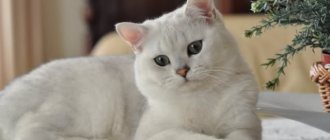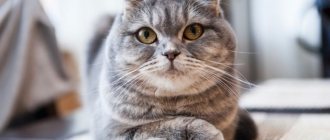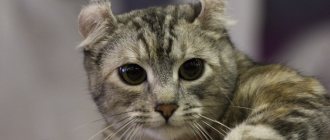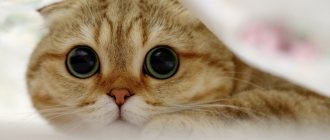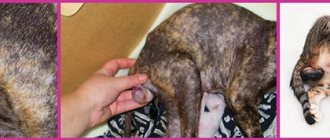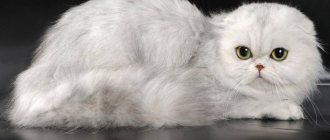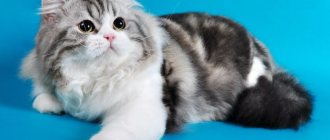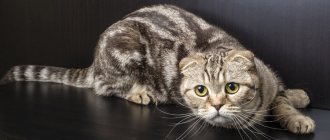The British Fold is one of the most recognizable cat breeds in the world, although many do not recognize it and classify it as the Scottish Fold. Most often, even people who have nothing to do with cats recognize the pearl-gray fur, huge sad eyes and charming ears. British cats are gentle creatures and therefore require special care and nutrition.
Despite the fact that not all breeders recognize the existence of British Fold cats as a separate breed, they have gained popularity among animal lovers since their inception. Their gentle nature, charming appearance and considerable intelligence make them excellent companions even for families with children.
Unofficial breed
Everyone knows the Scots precisely because of their characteristic feature - forward-curved ears, slightly hanging down in the direction of their gaze. They add incredible charm and recognition to the pet, and also cause affection among the owners.
The first mentions of such pets were found in China, and in Scotland they became popular only in 1959 thanks to William Ross and his farmer neighbor. It was they who decided to give rise to a new breed, but further research showed that the lop-eared gene weakens the animal’s cartilage.
Crossing purebred Folds with each other caused serious musculoskeletal problems in the offspring, which became the basis for banning their breeding.
Therefore, breeders began to combine fold-eared cats with straight-eared cats, for which the British and Americans with short hair were excellent. This made it possible to almost completely eliminate the defect and obtain Scottish Folds with hanging ears and Scottish Straights with straight ones. Mating them together produces a varied but healthy litter, which breeders use to this day. This breed spread to Russia at the end of the last century.
Straight-eared British cat, not to be confused with fold ears
After breeding the Scottish Fold, experiments were carried out to cross the British with them, and as a result the British Fold was obtained. This is a conditional name, since they were bred not so long ago and were not registered by the International Felinological Association. Due to this origin, there can be no talk about the purity of the blood or pedigree of the pets.
In addition, they differ from purebred Scots in their stocky, powerful body, and from the British in the shape of their ears.
Controversial issues
The British Fold is a rather controversial cat breed. And the dispute lies in the very shape of the ears. British cats have straight ears, but not fold ears . Straight, rounded and erect ears are characteristic of this breed. At that time, they could be confused with Scottish cats. Since this breed has 2 types of ears, one of which is straight ears.
The British paws look more massive due to their length. The cat's head is round, has large saggy cheeks and clearly defined cheekbones. The English cat is distinguished by its rounded tail.
Scottish Straight © shutterstock
Kinds
There are 4 types of Scottish cats, two of which are fold-eared. These are the Scottish Fold and Highland Fold subspecies.
A subspecies of the Scottish Fold breed is a short-haired, fold-eared Scottish cat. Its distinctive feature is ears that wrap around the head, large eyes, a round muzzle and head. Most people prefer this type of lop-eared cat because it produces less fur throughout the house.
The character of the Scottish Fold is another parameter for which this breed is adored by millions of cat lovers around the world. The fold-eared cat is absolutely not aggressive, soft and affectionate. She gets along easily with both humans and pets.
Unfortunately, the lop ear gene leads to many diseases, especially joint diseases. The future owner of the cat must be aware of this feature and properly care for the pet.
The Highland Fold is the second variety of the Scottish Fold cat, only with long hair. Some representatives of the breed can be so fluffy that they look like a big furry ball without ears.
The Highland Fold's character is the same as its short-haired counterpart - calm, non-conflicting and compliant.
Description of the breed, behavioral characteristics
A British Fold cat will look like a teddy bear with folded ears. That is, he takes over most of his features from his British relative - plump cheeks on a rounded head, a stocky body with short legs, stuffed soft fur. The color can be any, although gray-blue representatives are more common, and in large eyes a honey tint predominates.
He absorbed a lot from the folds, in particular, drooping ears, flexibility of the body and basic habits. So, each animal has its own habits and behavioral characteristics, individual, but something common will appear in them:
- The “column” position while sitting on your butt or standing on your hind legs with a straight back looks very amusing and funny. Few people know that it allows you to straighten the vertebrae and stretch your back, so it is rather a necessity.
- The absence of jealousy towards other animals, a friendly attitude towards everyone allows him to be kept in the same house even with dogs. It is thanks to his friendliness and playfulness that he becomes a favorite among children, and his obedient and gentle disposition will delight older people.
- A considerable appetite can lead to problems with the pet’s weight, which should not be allowed. In a cat over 3 years old, it can reach 8 kilograms, while female cats are usually smaller. To avoid pathologies, you should feed him 3-4 times a day, carefully dosing the food.
Description of character
Despite the differences between the British Fold and his ancestors from essentially different breeds, he took the best - incredible friendliness and affection for his owners, balanced disposition and calmness. He loves games, but he never imposes himself, and is also easy to basic training.
To get an obedient pet with a gentle disposition, the owner is required to give up unreasonable aggression and rudeness towards him.
"Lop-eared" becomes attached to the owner
This cat loves to eat, which may be why she quickly becomes attached to the person who feeds her. Therefore, it is advisable that the owner himself does this if he wants to receive devotion and obedience in response to care and affection.
Such a pet is independent and self-sufficient, and is considered an ideal option for a person who is busy at work for a long time.
So, he can remain alone for a long time, but he will always happily meet the person to whom he is attached.
In addition, the cat loves to just sit next to the owner or work with a claw sharpener, and if necessary, he will easily support the game he has started. But at the same time he never sits in his arms and does not tolerate hugs.
Temperament
Like the Scottish Fold, the British Fold is very inquisitive and gentle. Therefore, the maximum that you can get from him in case of dissatisfaction is a loud cry and a dissatisfied look.
It is also worth remembering that a long flexible tail is a pet’s special pride, and, in his opinion, always requires careful handling.
The British is clean and always looks respectable, which should also be remembered. That is, you need to be prepared for the fact that it will require constant attention from a person.
He is very independent and independent, requires personal space and respect from people. Without receiving anything, he will begin to show his dissatisfaction, which will lead to problems in mutual understanding.
In general, a cat can be either calm and balanced, or active and restless, which manifests itself in each individual case in its own way.
Pride in such a representative of the family can be combined with playfulness, and gentleness of character with an interest in hunting and tracking down the intended prey.
Relationships with other household members (children and dogs)
The behavior of the Fold remains friendly to everyone; he does not perceive aggression from the outside and does not show it himself. He gets along well with dogs and other pets. He dotes on children, playing with babies and cuddling with them for hours or falling asleep next to the child. Also read the article about the best cat breeds for children.
The main rule here is not to touch the tail and not to offend it in general, otherwise the cat will simply run away, maybe even leave the house.
In some cases, teeth and claws can be used against adults, but such a negative attitude will manifest itself immediately, because they do not know how to harbor a grudge. We recommend reading the article about breeds prone to aggression.
Gender of the animal
It is believed that females are more prone to catching mice than males. The fact is that cats have a highly developed sexual instinct, which sometimes prevents them from fulfilling their hunting duties. But the cat, on the contrary, is more inclined to hunt, because She has a nature to feed her offspring in the future. Of course, during estrus, the pet is unlikely to think about mice, but this period does not last long, and soon the cat is ready for exploits again.
In general, animals of both sexes will be able to catch mice, it’s just that males will do it more for fun, and females, even sterilized, will obey the survival instinct.
Colors
The luxurious plush coat of the British Fold is always stuffed and soft to the touch, and thanks to the cleanliness of this breed, it is always shiny and looks well-groomed. At the same time, kitties have a neat and gentle appearance, while cats can be slightly disheveled.
Colors can take on a wide variety of shades and patterns, including:
- Single color solid. Gray-blue representatives are more common, although some have fur that can be red, black, grey, brown, lilac, and less commonly white or peach.
Solid white
- Striped, marbled or spotted colors are indicated by adding the word "tabby" to the base color. At the same time, on a lighter base there are dark stripes, stains or spots that form the letter “M” on the forehead.
Tabby
- A smoky shade appears when each hair is colored only a third of the main color, and a chinchilla shade - if it is an eighth. The rest of the fibers may be silver or white. Also read the article about the British chinchilla.
Chinchilla shade
- The Siamese Colored has a light body with darker limbs. Thus, chocolate or almost black paws, tail, ears and muzzle stand out against a cream background.
Siamese Colored
- Tortoiseshell coloration is often black with splashes of different shades of red. Sometimes cream can be combined with gray or brown.
Tortoiseshell coloring
- Bicolor has two colors - white with blue, chocolate, black. Light in the lower part of the body, combined with tortoiseshell at the top, forms the “calico” color, characteristic of Scottish cats.
Color Bicolor
British fold cat color
The coat of representatives of the species has such properties as softness, silkiness, and a variety of colors. The wool can be plain or multi-colored, combining 2-3 colors.
Pixie bob cat is an interesting breed
Solid colors can be:
- light blue;
- ash-gray;
- white;
- brown;
- black;
- peach;
- richly red.
Coat color combinations can be tabby (striped, clearly defined color), haze, bicolor (a combination of light and dark shades), Siamese or tortoiseshell.
Note! The presence of the French Blue cat among the ancestors determines the basic monochromatic light blue shade of the coat, which is recognized as a classic.
Maintenance and care
The British Fold does not require special attention, since he gets used to looking after himself from an early age, repeating the movements of his mother. But still its content implies:
- regular feeding with either dry food or natural products, and always a full drinking bowl;
- cleansing the ears of wax, dirt and other accumulations, at least once every 2 weeks, using a special liquid and cotton swabs;
- combing the undercoat with special brushes at least once a week, and for a long-haired pet - at least three times, possibly against the grain;
- daily removal of dark discharge from the corners of the eyes with a napkin soaked in boiled water;
- cutting the claws every 3 weeks by 2-3 millimeters with a nail clipper and scratching post, examining them against the light to avoid getting on the vessel (only for cats that do not go outside);
- examination of the ears for rashes and eyes for purulent discharge, in which case you should visit a veterinarian;
- bathing no more than once every six months if there is an urgent need for warm water, the temperature of which does not exceed +40 degrees.
In addition, from an early age it is important to allocate personal space for the kitten, arrange a toilet and a place to sleep, and install a claw sharpener. Then he will quickly get used to the new housing and owners.
Proper care includes a balanced diet, 2-3 times a day in small portions.
A mixed diet is not recommended for this breed, that is, you should give the cat either ready-made food or natural products:
- lean meats - raw beef or turkey, boiled chicken, boneless and skinless fish;
- milk, fermented milk products and cottage cheese, less often you can pamper your pet with cream or sour cream, but not more than 2 times a month;
- oats, millet, rice can be cooked in broth with the addition of meat;
- cabbage, cucumbers, carrots and zucchini will fill the body with vitamins.
Own territory
British Folds can be called lovers of personal space. Yes, they need privacy, to be with themselves. Unlike other cats, this breed cannot be scared away by rustling bags; they are quite brave. Such attempts to scare away will, at most, result in a surprised face.
Once again, it is worth noting that pets get along well with other animals and are not jealous.
If they tell you that an animal chooses its owner, you can smile - this is not about the British. Pets tend to look at what is happening from above; they can climb to a height and watch what is happening like an emperor.
Health, reproduction, kittens
British Folds were created through crossbreeding, so they can be quite sickly.
In particular, they have a high risk of developing the following pathologies:
- Deformation of cartilage in some individuals affects not only the shape of the ears, but also the entire spine. Therefore, they may experience fusion of the vertebrae, shortening of bones and thickening of joints, and the appearance of bone growths, which can only be corrected surgically.
- Hypertrophic cardiomyopathy (HCM) is a genetically determined uneven thickening of the interventricular septum and ventricular walls. Progresses to heart failure with chest pain. The disease makes itself felt in individuals after a year and is detected by ultrasound.
- Obesity. Due to a good appetite, if you do not monitor your pet’s nutrition and activity, it can gain excess weight quite quickly. This in turn will lead to many health problems. A proper diet, outdoor games and plenty of space in the house or yard increases his activity and reduces the risk of illness.
- Worms, fleas and other parasites come from the outside, are absorbed with food or hairballs when licking, especially if the cat is in contact with other animals. Now there are many means to get rid of them, which are best used as prescribed by a veterinarian.
- Infectious diseases. These are immunodeficiency, aspergillosis with chronic runny nose, calcivirosis and rhinotracheitis. And especially life-threatening peritonitis, panleukopenia, leukemia, rabies, tuberculosis. To prevent them, vaccinations are necessary: annual against rabies starting from the age of 8 months, and others no later than the three-year period when maternal immunity is still in effect.
On average, adults live from 14 to 20 years if you monitor their condition.
For example, periodically lifting an animal by its front legs reduces the likelihood of developing spinal pathologies. Timely and proper care will avoid many other problems.
Particular attention should be paid to the issue of breeding pets. If owners want to get healthy offspring, under no circumstances should individuals with the same gene be crossed when both of them have drooping ears.
It is worth taking individuals with straight and curved ears, it is better if both of them belong to the British breed. And after 9 weeks it will be possible to get a mixed litter, but the likelihood of their mutation is significantly reduced.
The peculiarity of lop-eared cats is that they are all born with erect ears. They acquire their shape only on the 21st day, then it will be clear which of the babies will be straight-eared and which will be a typical representative of the British breed.
The owners will only have to choose suitable nicknames, remembering that the British are proud and independent animals, and they will serve their family faithfully.
Highland fold
It should be noted that the Highland Fold cat breed is characterized by a compact body of medium size and a weight not exceeding 4 kg. The body is round, proportional, ending in a flexible tail that tapers to the tip, the legs are of medium length with round paws. The head is beautiful, having a rounded shape with a strong-willed chin, a short nose with a small dimple located at the transition from the nose to the forehead and a well-developed jaw.
The eyes are huge, widely spaced, perfectly matching and in harmony with the shade of the coat. The coat is long and dense, uniform, of various shades, becoming a little cottony in adult animals, which is a minor drawback.
The Highland Fold is a good-natured cat that loves its owners madly and treats family members with deep respect and reverence.
They get along well with children and get along with all pets. Cats are smart, quick-witted and playful; they can never cause any harm to children while playing; they do not tear curtains or scratch furniture. They completely lack the aggressiveness that is inherent in certain breeds.
To summarize this article, I would like to note that fold-eared cats are very unpretentious and intelligent, and you can find the answer to the question - how much does a fold-eared cat cost on the Internet without any problems. Cats of this breed get along well with people and even dogs. Fold cats are recommended for purchase as one of the best pets.
Price
Separately, it is worth mentioning the cost of such a baby. Since the British Fold was not identified as a separate breed, they cost less than purebred British or Scots.
Although the pricing policy largely depends on other factors - the age of the cat, his appearance and character, whether he has a pedigree and a veterinary passport:
- if the owners are members of the club and can show the parents of the resulting offspring, provided certificates and vaccinated babies from 3 months, the price reaches 20-35 thousand rubles;
- club British 4-6 months will cost 10-15 thousand rubles, and at the age of 8-11 months. the price is still decreasing;
- From breeders, small kittens with a pedigree and vaccination certificate can be bought for 5-10, from six months old - for 2, and from a year old - even for 1 thousand rubles;
- if you take a cat from your hands, from a nursery or on the market, then the cost can vary from 500 to 5000 rubles and depends on the agreement with the owners.
In Russia there are quite a lot of breeders and clubs representing cats of this breed. Affectionate and friendly, fold-eared cats are quite popular in the country.

